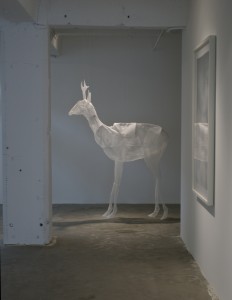SARAH WAGNER
Chattanooga, TN
May 2009
by Denise Sanabria
The Artist as Alchemist features two contrasting, dynamic installations: Sarah Wagner’s Nuclear Family and Born Between Piss and Shit by Jade Townsend (Cress Gallery, University of Tennessee/Chattanooga; October 14 – November 26, 2008). Both artists produce life-size tableaux into which they invite us to enter. Wagner’s installation is completely ethereal and Townsend’s uncompromisingly solid.
In 1986, the Chernobyl nuclear accident poisoned a large area of the Ukraine. Death, sickness, and deformities followed the event. Over twenty tears later, more animals live in the area than ever before. While reading about the research conducted on the present-day forest by journalist Mary Mycio in Wormwood Forest, A Natural History of Chernobyl, reports of large numbers of healthy roe deer – living seemingly unaffected in the post-human disaster zone today – grabbed Wagner’s attention. In her installation Nuclear Family, she uses environmentally friendly materials to portray these fragile life forms, surviving almost unknown in this lost world.
Four life-size deer appear to have wandered into the Cress gallery space, where they seem somewhat oblivious but alert. Raw silk organza covers their paperboard skeletons. A large, antlered male stands guard at the entrance to the high-ceilinged double room’s annex. Suspended with silk thread, he appears as consequential as fog. Inside the annex, another standing deer raises a back hoof to scratch behind an ear. At the far end, an adult female has lain down next to her fawn. The bathe in an unnatural, threatening orange glow produced by special lighting.
Wagner’s technical mastery is breathtaking. While fabric is a familiar and seemingly approachable medium, few sculptors can use it successfully to portray complex three-dimensional forms or replicate living creatures. The construction of the animals reveals a thorough knowledge of the intricacies of both form, broken down into geometric elements, and garment construction. Each animal is made up of scores of small pieces of fabric. In some instances, the fabric needed stretch over the underlying frame was cut on the weave’s bias angle to allow expansion and draping. Small darts were sewn in whenever a subtle curve was needed. All of the seams reinforce the lines of the deer’s form. Visible through the gossamer surface, these seams are trimmed flawlessly. Every tiny detail of the animal’s anatomy is reproduced. The transparent creatures emanate elusive and alert life, breathing hope onto the ravaged land where the real deer live.
